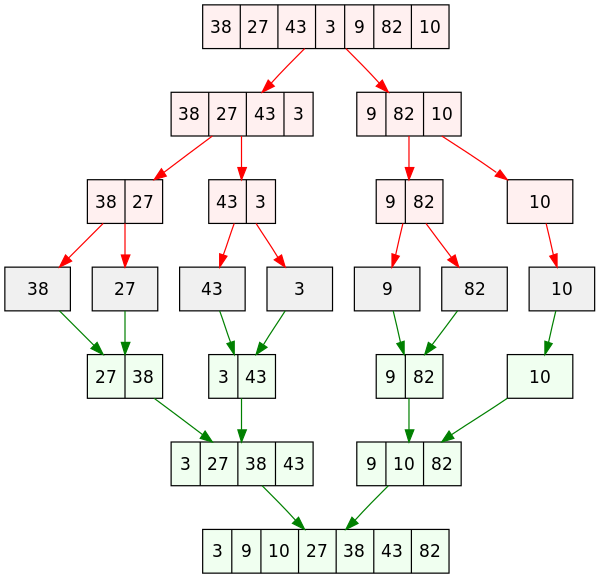Merge Sort
Merge sort is an O(nlogn) runtime sorting algorithm. O(nlogn) is the fastest sorting time when sorting comparable objects. Merge sort is a divide and conquer algorithm since it breaks down the problem into smaller subproblems and solves the larger problem that way.
Algorithm:
- Divide the list into the smallest unit (1 element)
- Compare each element with the adjacent list
- Sort and merge the two adjacent lists.
All the elements are sorted and merged:
Before proceeding to the code try to implement the algorithm on your own.
Solution (in java):
public class MergeSort {
public static void main(String[] args) {
// input array
int[] arr = {2, 6, 3, 9, 7, 5, 1, 4, 8};
// Call merge sort
mergeSort(arr);
// Check the output (should be sorted)
System.out.println(java.util.Arrays.toString(arr));
}
public static int[] mergeSort(int[] list) {
// do nothing if list is empty
if (list.length <= 1) {
return list;
}
// Create 2 lists to hold 1st and 2nd half of the list
int[] first = new int[list.length / 2];
int[] second = new int[list.length - first.length];
// Split the array in half and populate above lists
System.arraycopy(list, 0, first, 0, first.length);
System.arraycopy(list, first.length, second, 0, second.length);
// Sort each half recursively
mergeSort(first);
mergeSort(second);
// Merge both halves together
merge(first, second, list);
return list;
}
private static void merge(int[] first, int[] second, int[] result) {
// Index Position in first array - starting with first element
int iFirst = 0;
// Index Position in second array - starting with first element
int iSecond = 0;
// Index Position in merged array - starting with first position
int iMerged = 0;
// Compare elements at iFirst and iSecond,
// and move smaller element at iMerged
while (iFirst < first.length && iSecond < second.length) {
if (first[iFirst] < second[iSecond]) {
result[iMerged] = first[iFirst];
iFirst++;
} else {
result[iMerged] = second[iSecond];
iSecond++;
}
iMerged++;
}
// copy remaining elements from both halves
System.arraycopy(first, iFirst, result, iMerged, first.length - iFirst);
System.arraycopy(second, iSecond, result, iMerged, second.length - iSecond);
}
}
output:
[1, 2, 3, 4, 5, 6, 7, 8, 9]
Recursion can be tricky, so as you follow along make sure to have paper and pencil to draw down each step.
Clarifications:
The function arraycopy lies in the System class. It copies an array from the specified source array, beginning at the specified position, to the specified position of the destination array:
public static void arraycopy(Object src, int srcPos, Object dest, int destPos, int length)
Parameters:
- src − The source array
- srcPos − The starting position in the source array
- dest − The destination array
- destPos − The starting position in the destination data
- length − The number of array elements to be copied

